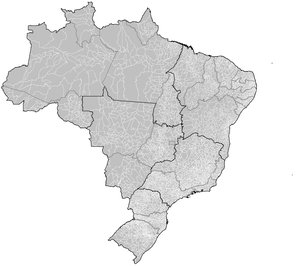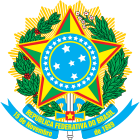Municipalities of Brazil

Municipalities of Brazil by state
Brazil |
|---|
 |
This article is part of a series on the politics and government of Brazil |
Executive
|
Legislative
|
Judiciary
|
Law
|
Administrative divisions
|
Recent elections
|
Foreign relations |
|
The municipalities of Brazil (Portuguese: Municípios do Brasil) are administrative divisions of the Brazilian states. At present, Brazil has 5,570 municipalities, making the average municipality population 34,361. The average state in Brazil has 214 municipalities. Roraima is the least subdivided state, with 15 municipalities, while Minas Gerais is the most subdivided state, with 853.
The Federal District cannot be divided into municipalities, according to the Brazilian Constitution, the Federal District assumes the same constitutional and legal powers, attributions and obligations of the states and municipalities, instead, it is divided by administrative regions.
The 1988 Brazilian Constitution treats the municipalities as parts of the Federation and not simply dependent subdivisions of the states. Each municipality has an autonomous local government, comprising a mayor (prefeito) and a legislative body called municipal chamber (câmara municipal). Both the local government and the legislative body are directly elected by the population every four years. These elections take place at the same time all over the country; the last municipal elections were held on October 2, 2016. Each municipality has the constitutional power to approve its own laws, as well as collecting taxes and receiving funds from the state and federal governments.[1] However, municipal governments have no judicial power, and courts are only organised at the state or federal level. A subdivision of the state judiciary, or comarca, can either correspond to an individual municipality or encompass several municipalities.
The seat of the municipal administration is a nominated city (cidade), with no specification in the law about the minimum population, area or facilities. The city always has the same name as the municipality, as they are not treated as distinct entities. Municipalities can be subdivided, only for administrative purposes, into districts (normally, new municipalities are formed from these districts). Other populated sites are villages, but with no legal effect or regulation. Almost all municipalities are subdivided into neighbourhoods (bairros), although most municipalities do not officially define their neighbourhood limits (usually small cities in the countryside).
Municipalities can be split or merged to form new municipalities within the borders of the state, if the population of the involved municipalities expresses a desire to do so in a plebiscite.[1] However, these must abide by the Brazilian Constitution, and forming exclaves or seceding from the state or union is expressly forbidden.[1]
A
- Municipalities of Acre (AC)
- Municipalities of Alagoas (AL)
- Municipalities of Amapá (AP)
- Municipalities of Amazonas (AM)
B
- Municipalities of Bahia (BA)
C
- Municipalities of Ceará (CE)
E
- Municipalities of Espírito Santo (ES)
G
- Municipalities of Goiás (GO)
M
- Municipalities of Maranhão (MA)
- Municipalities of Mato Grosso (MT)
- Municipalities of Mato Grosso do Sul (MS)
- Municipalities of Minas Gerais (MG)
P
- Municipalities of Pará (PA)
- Municipalities of Paraíba (PB)
- Municipalities of Paraná (PR)
- Municipalities of Pernambuco (PE)
- Municipalities of Piauí (PI)
R
- Municipalities of Rio de Janeiro (RJ)
- Municipalities of Rio Grande do Norte (RN)
- Municipalities of Rio Grande do Sul (RS)
- Municipalities of Rondônia (RO)
- Municipalities of Roraima (RR)
S
- Municipalities of Santa Catarina (SC)
- Municipalities of São Paulo (SP)
- Municipalities of Sergipe (SE)
T
- Municipalities of Tocantins (TO)
See also
- Lists of cities
- List of largest cities in Brazil
- List of municipalities of Brazil
Administrative region (Federal District)
References
^ abc "Constituição da República Federativa do Brasil de 1988". planalto.gov.br (in Portuguese). Brazil..mw-parser-output cite.citation{font-style:inherit}.mw-parser-output q{quotes:"""""""'""'"}.mw-parser-output code.cs1-code{color:inherit;background:inherit;border:inherit;padding:inherit}.mw-parser-output .cs1-lock-free a{background:url("//upload.wikimedia.org/wikipedia/commons/thumb/6/65/Lock-green.svg/9px-Lock-green.svg.png")no-repeat;background-position:right .1em center}.mw-parser-output .cs1-lock-limited a,.mw-parser-output .cs1-lock-registration a{background:url("//upload.wikimedia.org/wikipedia/commons/thumb/d/d6/Lock-gray-alt-2.svg/9px-Lock-gray-alt-2.svg.png")no-repeat;background-position:right .1em center}.mw-parser-output .cs1-lock-subscription a{background:url("//upload.wikimedia.org/wikipedia/commons/thumb/a/aa/Lock-red-alt-2.svg/9px-Lock-red-alt-2.svg.png")no-repeat;background-position:right .1em center}.mw-parser-output .cs1-subscription,.mw-parser-output .cs1-registration{color:#555}.mw-parser-output .cs1-subscription span,.mw-parser-output .cs1-registration span{border-bottom:1px dotted;cursor:help}.mw-parser-output .cs1-hidden-error{display:none;font-size:100%}.mw-parser-output .cs1-visible-error{font-size:100%}.mw-parser-output .cs1-subscription,.mw-parser-output .cs1-registration,.mw-parser-output .cs1-format{font-size:95%}.mw-parser-output .cs1-kern-left,.mw-parser-output .cs1-kern-wl-left{padding-left:0.2em}.mw-parser-output .cs1-kern-right,.mw-parser-output .cs1-kern-wl-right{padding-right:0.2em}
External links
| Wikimedia Commons has media related to Municipalities in Brazil. |
Map on the World Gazetteer at Archive.today (archived 2012-12-17)
(in Portuguese) Brazilian Institute of Geography and Statistics